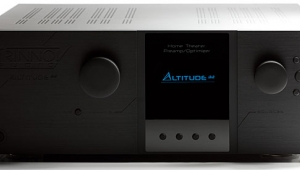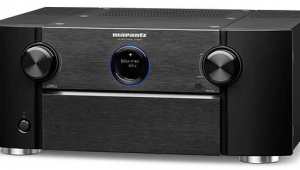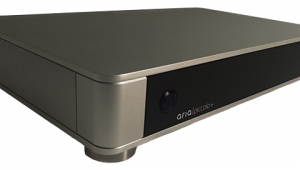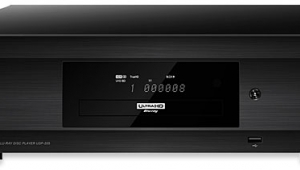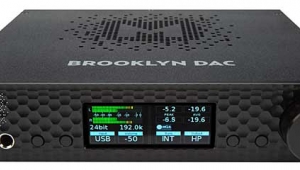| Columns Retired Columns & Blogs |
Music in the Round #40 Page 2
The subjective results with the PBK-1 were very good and satisfying, but, while easier to use and significantly less expensive, they were no better or worse than with the SVSound or Audyssey devices. Of course, the SUB 15 already contains the real guts of the Paradigm EQ system, so there should be no reason to even consider buying one of the other EQs. Measurement of the actual performance of the SUB 15 with PBK-1, using the XTZ Room Analyzer, revealed that: 1) there was no correctable modal behavior, 2) the response was flat within ±2dB from about 100Hz down to 15Hz (which is absolutely remarkable), and 3) while there were no detectable modes, the decay times below 100Hz were somewhat more extended than I'd achieved with the SVS AS-EQ-1 (footnote 1). However, the PBK-1 made a huge improvement in the SUB 15's bass performance compared with that of the Arcam AV888 that I reviewed in November 2009, such that running the PBK-1 before running the Arcam's auto setup/EQ was almost obligatory.
Footnote 1: While I think it's fair to compare XTZ measurements made using the different devices, it's not justifiable to compare what the XTZ shows with three mike positions with what the PBK-1 or the SVSound or the Audyssey determines from six or more positions. The measurement is merely a snapshot.
I hail Paradigm's Reference Studio SUB 15 as a worthy successor to its Reference Servo-15. The SUB 15 offers all the powerful bass and extension needed for any music and, indeed, for home theater, unless you're a bass maniac. (If you are, get two or more SUB 15s.) The PBK-1, the SUB 15's obvious mate, will work with up to four Paradigm subwoofers, and is a bargain at $250. However, with sophisticated room EQ now built into almost all modern pre-pros, I wonder how much of a market there is for dedicated subwoofer EQ for most multichannel systems. They remain obligatory for two-channel and analog multichannel systems, but beyond that, I can easily imagine a multi–SUB 15 system with PBK-1 applied to each, all connected to an Anthem Statement D2v, with ARC integrating the whole shebang.
Audyssey Sub Equalizer
It was only yesterday that I reviewed the SVSound AS-EQ1—well, it was last September. I had it only briefly, and now I have its twin: the Audyssey Sub Equalizer (each model costs $799). In fact, with their magnetically held front panels detached, there's no way to distinguish them physically. And yet there are differences. Purchasers of the SVS get a measurement program disc and a calibrated microphone similar to that used with higher-level Audyssey-equipped A/V receivers and pre-pros; it requires no external mike preamp. The Audyssey Sub Equalizer comes with zilch. Nada. It must be used with the Audyssey MultEQ Pro software (footnote 2) and its supporting hardware kit. This means that installation should be done by an Audyssey-trained installer, though I know of many private users who have done it themselves. It also means that installing the Sub Equalizer will benefit from the Pro's more sophisticated software and its hardware kit's superior mike and preamp. Because the Sub Equalizer is physically identical to the SVSound AS-EQ1, I'll spare you a description of its front and rear panels and its basic pattern of interconnections. The only physical difference is the powered mike preamp in the line for the Sub Equalizer.

The only functional difference between the models that I could find was that while the AS-EQ1 will handle two subs, it assumes they will both be in the same room/system. The Audyssey Sub Equalizer can handle two subs, either in the same or different rooms. However, while the two products can be used similarly, SVSound advises users to run whatever system setup and equalization they have on their AVR or pre-pro once before doing any measuring with the AS-EQ1. They include a procedure, AutoEQ Assist, and a bypass cable, with which the resident equalizer can be fooled into thinking it's attached to a virtually perfect subwoofer and thus apply no EQ to the sub channel. After that, you run the AS-EQ1 measurements and calibrations, then manually transfer to the main processor the level and distance recommended for the sub. This precludes the superimposition of two redundant and possibly conflicting corrections to the sub channel. On the other hand, the fact that the Sub Equalizer must be used with Audyssey MultEQ Pro means that, more than likely, the Sub Equalizer will be used with an Audyssey MultEQ Pro-compatible processor. In this case, the preferred procedure would be to run the Sub Equalizer measurements and calibration first. Then, when Audyssey MultEQ Pro does the setup and EQ for the main processor, it will theoretically find a virtually perfect sub(s) and not impose additional EQ.

What's going on? If the SVSound AS-EQ1 and the Audyssey Sub Equalizer are fundamentally identical, why are we singing different tunes? I think it's because the AS-EQ1, as an independent component, is likely to be used with processors that use setup and EQ systems other than Audyssey's. On the other hand, I think it's reasonable to expect that anyone buying a Sub Equalizer will use it with an Audyssey MultEQ Pro-compatible version of Audyssey MultEQ XT, either built into a processor or in the form of the Audyssey Sound Equalizer. In fact, you can use either device either way, but Audyssey seems to have greater respect for the proper compatibility of its own products. Naturally.
So I followed the rules. I inserted the Sub Equalizer between my Integra DTC-9.8 preamplifier-processor and my two Paradigm subs, the Servo-15 and SUB 15; to my computer, via USB; and to the pre-pro's center-channel analog input. Audyssey MultEQ Pro guided me through balancing the two subs' levels with that channel, a procedure best repeated—the software seems to make a slow, rolling average of the measurements. After several repetitions, good stability of the result was achieved, and the three channels were within 0.2dB of each other, even though Audyssey's window of allowable difference is 3dB. After that came the now-familiar procedure of EQing the two subs by taking measurements at my six standard positions with the Sub Equalizer in a 1-in/2-out configuration. The results were excellent and, not too surprisingly, nearly identical to what I'd achieved with the SVSound AS-EQ1. The AudysseyPro also gave me values for the subwoofer's level (–3dB) and distance from the listening position (32', footnote 3) to enter into the DTC-9.8's set-up menu.
I restarted Audyssey MultEQ Pro with the microphone and preamp connected to the Integra's Aux 1 input, then repeated the process to recalibrate the remaining five channels with MultEQ XT. As I have in the past, I used my edited-to-flat target curves, then adjusted the crossover frequencies to flatten each channel's frequency response in the range below 120Hz. The "before" frequency response of the subwoofer(s) channel was not quite "virtually" perfect—it showed some ripples—but the EQ'd "after" graph was absolutely flat down to 14Hz! More interesting from this run was that the distance indicated for the paired subs was nearly identical to that those recommended by the Sub Equalizer—to within 2'—and the indicated level was identical.
In terms of sound, though, this may be the "sweet spot" among all the various Audyssey options. While both the Sub Equalizer ($799) and the SVSound AS-EQ1 ($799) will get you the increased bass-filter resolution of Audyssey's standalone Sound Equalizer ($2500), they also offer a way to properly manage a pair of subwoofers, and cost less than a third as much. On the other hand, the combination of the Sub Equalizer with an Audyssey MultEQ Pro-compatible pre-pro or AVR gets you high-resolution sub correction, the additional accuracy of a superior microphone, the optimization facilities of AudysseyPro, and nearly the same resolution in the main channels, where I think it is less critical. The catch is getting your hands on Audyssey MultEQ Pro, which Audyssey thinks should be used only by professionals. In fact, careful and serious amateurs such as you and I are likely to devote more time and effort to the task, since we're not on the clock. And perhaps we'd get even more out of it.
Bottom Line
With sophisticated room EQ now being built into more and more multichannel preamplifier-processors, one might wonder about the real market for a dedicated subwoofer EQ. However, it seems that many mainstream makers of A/V receivers are dumbing down the equalization software in their newer, less expensive models, as they ask those models' DSP engines to do more and more tasks with the same horsepower. Compare, for example, the versions of the Audyssey software included in the lower-end 2008 models from Onkyo and Denon with what's included in the comparable 2010 models. For most users, that will be okay. However, if you're serious about bass but have a really difficult room and/or multiple subs, dedicated subwoofer correction—via the Paradigm's PBK-1, Audyssey's Subwoofer Equalizer, SVSound's AS-EQ1, VLSI Solution's Anti-Mode 8033, or other device—should be an excellent investment. In a stereo system (with a subwoofer) or an analog multichannel system, they should be obligatory.
Footnote 1: While I think it's fair to compare XTZ measurements made using the different devices, it's not justifiable to compare what the XTZ shows with three mike positions with what the PBK-1 or the SVSound or the Audyssey determines from six or more positions. The measurement is merely a snapshot.
Footnote 2: Audyssey MultEQ Pro was Stereophile's 2008 Joint Accessory of the Year.
Footnote 3: I don't know how to defeat the SUB 15's own EQ. To ensure that it was not a contributing factor, I swapped the positions of the two subs. The Servo-15 remained unequalized, and the SUB 15 was now effectively so, as reflected in my measurements. However, the intercession of the SUB 15's EQ DSP undoubtedly contributed to the long signal delay reflected in the indicated distance of the subs from the listener, as calculated by the Audyssey Sub EQ.
- Log in or register to post comments


